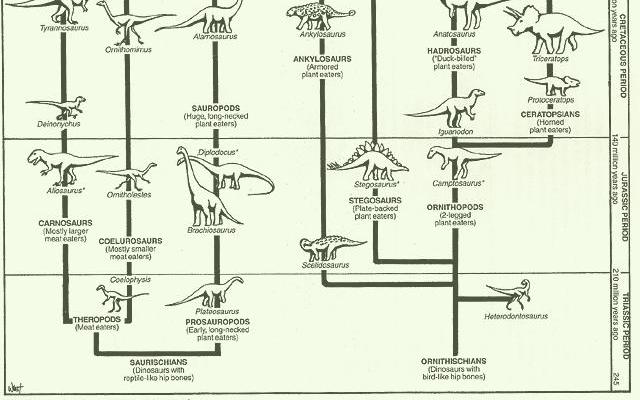|
By Eva Sophia Blake Edited by Kim Chia For over a century, dinosaurs have been classified using the system created by the paleontologist Harry Seeley. Matthew G. Baron, University of Cambridge Ph.D candidate, however, hopes to redefine and reconfigure how scientists organize dinosaurs. His work has been supported and encouraged by David B. Norman and Paul M. Barrett, his two advisors. Seeley’s system, created in 1888, divided dinosaurs into two main categories: the bird-hipped (Orinthischia) and the lizard-hipped (Saurischia). The bird-hipped includes armored dinosaurs like the stegosaurs while the lizard-hipped category describes dinosaurs such as the tyrannosaurs. The two groups were believed to be completely distinct, without a shared ancestor between them, till around 1980. This assumption formed how paleontologists understood the evolution of dinosaurs: the division illustrated to them evolutionary pathways. Baron’s new system calls much of the work done on dinosaurs into question. Baron’s study originates in what is called a “sister-group” relationship between a group in each main category, indicating that the two categories are not as distinct as was previously believed. In light of this discovery, Baron suggests that the two categories should be replaced by different ones. Once Baron realized that the distinction was not as certain, he spent the following three years studying dinosaur fossils. His goal was to find better features to distinguish between dinosaurs that would eventually create a new family tree.
After researching, Baron came up with 457 potential characteristics to organize the species through a wide-ranging evaluation of dinosaurs in both time and space. Overall, 74 different groups were scored for the diagnostic features that Baron had identified. This data was than analyzed using the computer program TNT 1.5-beta to create and evaluate 32 billion potential family trees. TNT lends weight to Baron’s system because of its advanced statistical ability. Baron’s recently published study “A new hypothesis of dinosaur relationships and early dinosaur evolution” focuses on the family tree evaluated as most accurate. This classification connects the bird-hipped Orinthischia category with the sub-category of Saurischia called Theropods. Because of this connection, Baron suggests two different main categories: the Orinthoscelida (a combination of the Orinthischia and theropods) and the Saurischia. This new distinction greatly changes the make-up of the family tree, suggesting a very different evolutionary story. This new classification indicates that the Orinthischia and the theropoda evolved at a similar point in time and from a joint ancestor. Based on this new information, dinosaurs are suggested to have existed about 247 million years ago during the middle Triassic era. The new tree also implies that the original dinosaurs were omnivorous and had grasping hands—a distinct evolutionary advantage primarily seen in humans. This trait explains dinosaurs’ success in comparison to other species in the Jurassic era. Additionally, while many have previously assumed dinosaurs emerged in South America, the new classification suggests that the Northern Hemisphere was an equally likely origin. Baron suggests Scotland as a potential origin point because the creature Saltopus elginesis has many similar features in common with the early dinosaur Baron has recreated. While the new classification is statistically supported as the most likely because of the use of the TNT programming, many paleontologists remain unconvinced. It is unclear whether the scientific community will adopt Baron’s potential system or continue to use the one that has existed for over a century. Paul Sereno, a paleontologist at the University of Chicago who has been a proponent and modern adaptor of Seeley’s original classification system, does not believe the new system has any significant contributions because of its lack of new features and scoring. Baron responded to this criticism by noting that rather than reconfiguring the characteristics, he simply created a classification that was unbiased towards the historical one. Specifically, the system TNT does not have the same information of preexisting systems that a scientist would. Baron’s article has certainly laid the groundwork for more conversation about classification. What remains to be seen is how other paleontologists will respond and how new data may eventually change the proposal.
0 Comments
Leave a Reply. |
Categories
All
Archives
April 2024
|


